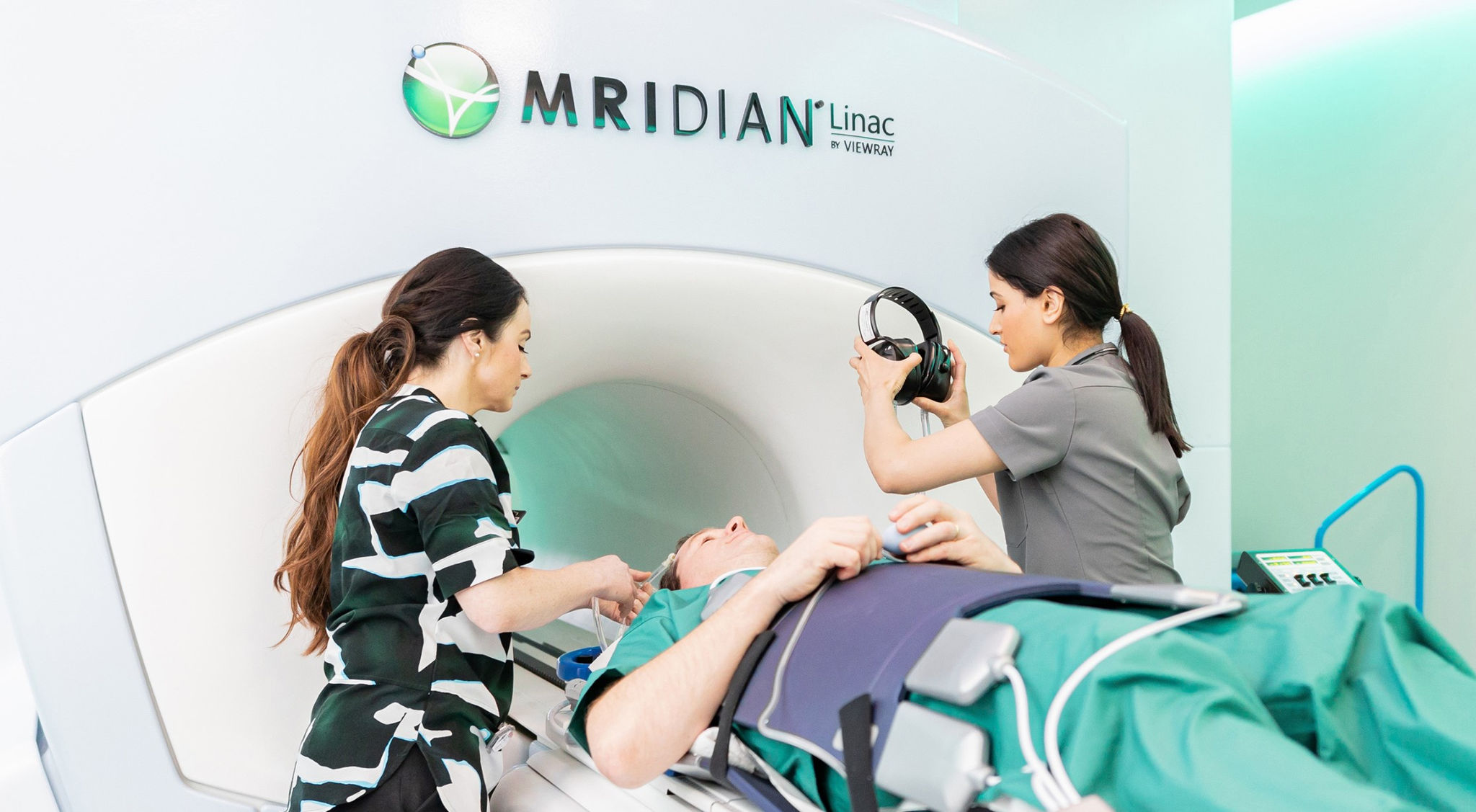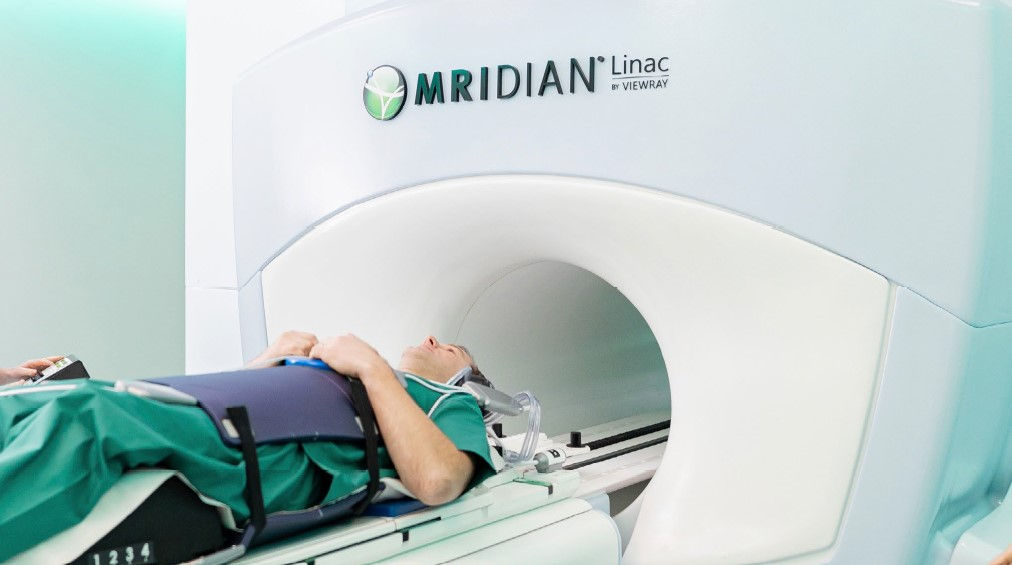- Healthcare Professionals
- Oncology
- Treatments
- Radiotherapy
- MRIdian for prostate cancer
Introducing the MRIdian – an evidence-based treatment for prostate cancer
Treating prostate cancer with radiotherapy can be difficult due to the naturally occurring movement of the surrounding internal organs. Until now, conventional linacs have had to rely on computer tomography (CT) scans to define the treatment area. However, this can cause uncertainty and inaccuracy when delivering radiotherapy due to the large planning target volume margins required.
The MRIdian MR linac makes it possible to deliver magnetic resonance image guided radiotherapy (MRIgRT) in a way that targets tumour sites in real-time and is supported by a wealth of clinical research.
A recent Phase III randomised clinical trial demonstrated that using MRI guidance to deliver 5# stereotactic ablative radiotherapy (SABR) to patients with localised prostate cancer reduced levels of genitourinary and gastrointestinal toxicity1. This, in part, is thanks to the MRIdian’s unique facility for ‘automated beam gating’ – a state-of-the-art system that only delivers the radiotherapy dose when the tumour is positioned inside the treatment boundaries.
We're proud to be the first independent healthcare provider to introduce the first two MR linacs of this kind to the UK market. So far, we have treated more than 830* patients using these world-class radiotherapy systems at our centres in Oxford and Cromwell Hospital London.
An additional MRIdian will also be accessible in our state-of-the-art centre currently under construction in Guildford, opening in December 2023.
*Figure accurate as of February 2023
Refer a patient
Making a referral is easy. Please complete our online referral form or request a call back.
An efficient radiotherapy solution
Adaptive radiotherapy offers added confidence to SABR delivery
MRIgRT is one of the biggest and most exciting developments to happen in advanced radiotherapy in recent years.
By combining a linear accelerator with a high-definition MRI scanner, MRIdian makes truly adaptive SABR delivery possible for the first time, allowing clinicians to actively visualise the treatment area and feel more confident when delivering treatments.
MRIdian also greatly improves on conventional image-guided radiotherapy, in that it allows tracking of the target position in real time and offers millimetric levels of accuracy. These attributes open multiple new avenues of delivering high doses of radiation to transitional tumour sites within close proximity of organs at risk.
Recently, there has also been a growing body of evidence to support 5# SABR delivered on the MRIdian for patients with low to intermediate-risk and selected high-risk localised prostate cancer. This can provide a variety of additional benefits to patients.
Benefits for patients with prostate cancer
A non-surgical alternative
MRI-guided 5# SABR for prostate cancer is a less invasive, non-surgical treatment that can reduce patient waiting times and hospital stays.
Reduced toxicity levels
Patients treated with MRI-guided 5# SABR show reduced gastrointestinal and genitourinary side effects when compared to moderate hypofractionation1.
Fewer treatment sessions
A reduced number of treatment sessions leads to fewer and less severe side effects and less interruption in the patient's daily life.

Prostate patient eligibility
What are the inclusion criteria?
- Aged 18 years or older
- WHO performance score 0-2 or Karnofsky performance status 70-100%
- Biopsy proven adenocarcinoma of the prostate
- Gleason ≥ 6
- Prostate volume ≤ 90 cc on transrectal ultrasound (TRUS)
- International Prostate Symptoms Score (IPSS) ≤19
- T-stage: T1c-T3b (on MRI and/or endorectal ultrasound)
- No evidence of lymph node or distant metastases on radiological staging
- All patients should be able to undergo MRI scans
- Reviewed by a multidisciplinary team and external beam radiotherapy is an option for treatment
- Previous TURP is allowed provided there is at least eight weeks’ interval with radiotherapy
- The administration of concomitant hormonal therapy is allowed
What are the exclusion criteria?
- Previous irradiation in the pelvic region
- Contraindications for MRI
- Patients who have electronic devices such as pacemakers or implanted defibrillators, deep brain stimulators, cochlear implants
- Patients who have a metallic foreign body in their eye
- Patients who have an aneurysm clip in their brain
- Patients with severe claustrophobia may not be able to tolerate an MRI scan
- Patients with inflammatory bowel disease
What information is required to refer a patient for prostate radiotherapy on the MRIdian?
The minimum data set is:
- Prostate radiotherapy consent form
- MR-linac supplementary consent form
- Booking form (electronic/paper)
- Referral letter (letter referring the patient to the clinical oncologist)
- Histology report
- Prostate MRI report and images if possible
- GenesisCare MRIdian assessment pro forma
- Please note, on occasions some insurers may ask for a medical report.
Evidence base
There has been an increasing international evidence base for using 5# SABR, MR-linacs, and the MRIdian system specifically to treat prostate cancer.
Here are some of the key pieces of research to have been published over recent years.
A Phase II study conducted by researchers in Amsterdam discovered that using MRIgRT to treat patients with prostate cancer demonstrated a low incidence of early gastrointestinal (GI) and genitourinary (GU) toxicity in both clinician and patient-reported outcome measurements2.
These findings were hypothesised to be due to the smaller uncertainty margins and daily adaptive planning capabilities that MRIdian can provide when delivering SABR to patients.
A Phase III, randomised, non-inferiority trial known as PACE-B assessed the toxicity profiles of conventional fractionation or moderate hypofractionation versus 5# SABR.
Conducted at 35 hospitals across the UK, Ireland and Canada, 874 male patients were randomly assigned to receive either a control radiotherapy (78 Gy in 39 fractions over 7 – 8 weeks, changed to 62 Gy in 20 fractions over 4 weeks following a protocol amendment) or SABR (36.25 Gy in five fractions over 1 – 2 weeks).
The 2-year toxicity findings published in 2022 discovered that toxicity rates were similar across both groups3. The researchers concluded that SABR was a safe treatment for patients with prostate cancer and was associated with low rates of side effects.
The first Phase III randomised clinical trial of its kind, the MIRAGE trial compared the effects of using MRI guidance against CT guidance in the treatment of patients with prostate cancer when receiving 5# SABR at the same radiation dose1.
Conducted at the University of California, researchers found that using MRI guidance to deliver 5# SABR offered significant advantages over CT guidance; patients receiving MRI-guided SABR reported reduced levels of genitourinary and gastrointestinal toxicity and improved quality of life.
Discover more about the results of the MIRAGE trial.
The PACE-A study represents the world's first randomised trial to compare the long-term side effects of SABR against surgery in patients with early-stage prostate cancer.
After the study's results were presented at the 2023 ASCO Genitourinary Cancers Symposium, researchers from The Royal Marsden NHS Foundation Trust and The Institute of Cancer Research, London reported that significantly fewer men with prostate cancer needed to manage urinary incontinence symptoms (4.5%) compared with patients that received surgery (47%) after two years. Patients treated with SABR also reported improved sexual function after two years than those treated with surgery.
Patient case studies
Having treated more than 830* patients with prostate cancer using MRI-guided SABR, our specialist team has significant first-hand experience of witnessing how impactful MRIdian can be.
Listed below are some of our most noteworthy patient case studies.
*Figure accurate as of February 2023
A 77-year-old male with prostate cancer became the first UK patient of GenesisCare to receive treatment on the MRIdian in 2019. Presenting with a Prostate-Specific Antigen (PSA) level of 6.8, the patient was prescribed to receive 5# SABR at the VU University Medical Center in Amsterdam.
After experiencing some mild side effects within the first four weeks, the patient recorded no significant radiation-induced side effects and had a reduced PSA level of 4.6. Three months later, towards the end of January, this level dropped to 2.3 and in the first week of July 2020 was recorded at 1.3. He is now currently in remission.
A 62-year-old male was diagnosed with localised, high-risk prostate cancer in November 2019, presenting with a PSA level of 8.87 and a long history of rheumatoid arthritis (RA). To alleviate RA symptoms, the patient was receiving methotrexate – a radiosensitiser known to increase the toxic effects of radiotherapy(REF). To minimise the time the patient would be off methotrexate during his prostate cancer treatment, 5# SABR was delivered via MRIdian over a 10-day period.
Following the five treatment sessions, the patient commented that he didn't experience any significant bladder or bowel toxicities. At the six-week post-radiotherapy follow-up, the patient's PSA score was recorded as 0.09. He also experienced no flare-up of RA-related symptoms.
Discover more about our patient case studies.
MRIdian specialists at GenesisCare
Patient care on the MRIdian is delivered by a team of specially trained consultant oncologists, selected based on their clinical expertise. The team collectively provide a comprehensive infrastructure for patient selection, peer review and clinical governance for all referrals as well as the credentialing of new clinicians in MRI-guided radiotherapy.
Urology SABR Advisor Team
Our SABR service is spearheaded by the Urology SABR Advisor Team – a group comprised of leading oncologists that specialise in urology. The role of this group is to review all referrals to the GenesisCare service for urological cancers such as prostate cancer, improve patient access to SABR treatments, and contribute to the existing evidence base.
References
- Kishan A, Martin T, Lamb J, Casado M, et al. (2023). Magnetic Resonance Imaging–Guided vs Computed Tomography–Guided Stereotactic Body Radiotherapy for Prostate Cancer: The MIRAGE Randomized Clinical Trial. JAMA Oncol. e226558. doi: 10.1001/jamaoncol.2022.6558.
- Bruynzeel A, Tetar S, Oei S, Senan S, et al. (2019). A Prospective Single-Arm Phase 2 Study of Stereotactic Magnetic Resonance Guided Adaptive Radiation Therapy for Prostate Cancer: Early Toxicity Results. Int J Radiat Oncol Biol Phys. 105(5): 1086-1094.
- Tree A, Ostler P, van der Voet H, Chu W, et al. (2022). Intensity-modulated radiotherapy versus stereotactic body radiotherapy for prostate cancer (PACE-B): 2-year toxicity results from an open-label, randomised, phase 3, non-inferiority trial. Lancet Oncol. 23(10): 1308-1320.
- Spittle, M (1978). Methotrexate and Radiation. Int J Radiat Oncol Biol Phys. 4(1-2): 103-7.
Refer a patient
Making a referral is easy. Please complete our online referral form or request a call back.
